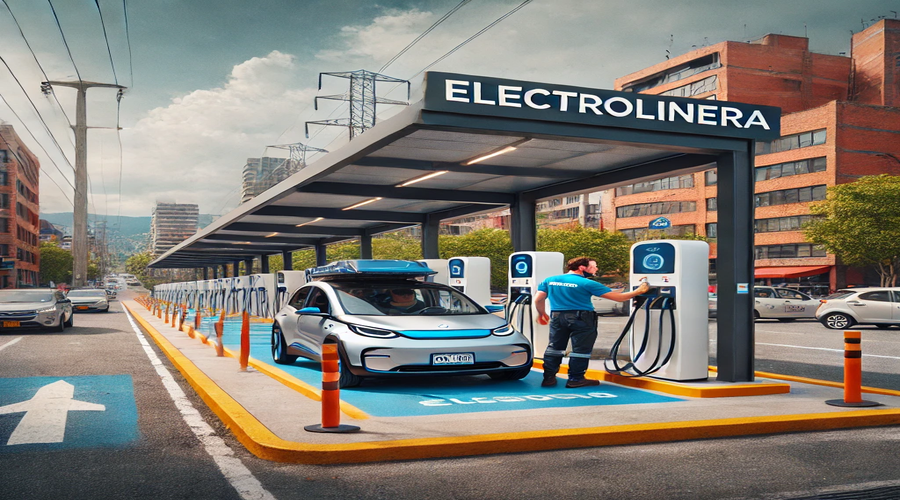Electric vehicle charging stations in Colombia must adhere to specific technical standards for their installation and operation. If these requirements are not clearly understood, the process can face delays.
In this context, the Technical Regulation of Electrical Installations (RETIE) and the Colombian Technical Standard NTC 2050 define the necessary conditions to ensure the safety and efficiency of the electrical system at charging points.
RETIE certification, mandatory for charging stations, regulates the safety of electrical installations.
As outlined in section 20.7 of the regulation, every charging station must hold a compliance certificate guaranteeing it meets safety standards.
This requirement is mandatory and must be issued by an accredited certification body.
Additionally, section 10.1 of the RETIE specifies that every electrical installation must have a design prepared by a legally competent professional.
This includes submitting detailed technical documentation, including electrical schematics and calculation reports.
Any changes to electrical infrastructure—whether building, expanding, or remodeling a charging station—must follow the parameters set by RETIE.
This entails undergoing inspection and certification before the system can be commissioned.
For larger-scale projects, such as charging stations with high energy demands, RETIE requires the installation of protective measures like grounding systems and lightning protection devices.
NTC 2050 and the requirements for installing charging equipment
The Colombian Technical Standard NTC 2050 complements RETIE by defining specific conditions for installing electric vehicle charging equipment.
In section 625, it details the criteria that charging systems must meet, including installation conditions, electrical protections, and location.
Installation conditions: The equipment must be designed to operate safely within the electrical parameters of Colombia’s grid.
Electrical protections: Emergency disconnection mechanisms and protection systems against overloads and short circuits must be included.
Location and identification: Charging stations must be clearly signposted according to the standards set out in the regulations.
Installing a charging station in Colombia can exceed $1,500 USD
Considering technical studies, legal procedures, materials, and certifications, the total cost can surpass 7 million Colombian pesos—equivalent to more than $1,500 USD—surprising many who plan to invest in such projects.
Furthermore, Colombia presents a unique scenario: according to data provided by USAENE and the Inter-American Development Bank (IDB), there are 186 charging stations nationwide. While Type 1 connectors are regulated, though not exclusively, up to seven different types of connectors prevail.
To ensure a safe and efficient rollout, the country has established technical and regulatory requirements for installing charging stations.
What are the steps to follow when installing a charging station in Colombia?
1. Initial site assessment
The first step in installing a charging station is evaluating the site’s needs and electrical capacity.
This analysis involves determining the required power, conducting a load study, and preparing a single-line diagram reflecting the project’s technical specifications.
These initial assessments, which cost approximately $850,000 COP, help ensure the conditions needed for the infrastructure to function properly.
2. Coordination with network operators
Next, it’s crucial to identify the grid operator and energy provider that will service the charging station’s location.
If the site lacks sufficient electrical capacity, a connection point must be arranged or a power upgrade requested.
This process can take up to 15 business days and requires documents such as utility bills, a form signed by the property owner, and, in some cases, additional permits if the site owner and the charging station owner are not the same.
The estimated cost for this step is $350,000 COP.
3. Design and plan approval
This phase, which can take up to a month, includes preparing electrical plans, risk analyses, grounding systems, and lighting designs.
These documents must be submitted to the network operator for approval, adding an estimated cost of around $3,000,000 COP.
Once approved, these designs are valid for one year and are essential to proceed with construction.
4. Construction and certification
During equipment installation, compliance with the RETIE standards is mandatory.
These regulations ensure the safety and quality of installations at charging stations.
An inspection is also required to certify the distribution, metering, and end-use stages.
This certification process costs approximately $2,950,000 COP and can take up to four weeks.
Once certification is obtained, the account and meter must be legalized with the network operator.
5. Legalization and registration
The final step involves registering the charging station with the relevant authorities and applying for available tax benefits, such as a deduction of up to 50% on income tax.
This process, coordinated with the Mining and Energy Planning Unit (UPME), can take several months.
From the initial assessment to the station’s commissioning, the total duration is estimated at 10 to 12 months.
Additional factors must also be considered, such as planning for future capacity expansions and ensuring compliance with interoperability standards.
In multi-tenant properties, for instance, installing a charging station may require approval from the condominium board, especially if the project involves significant structural changes.










